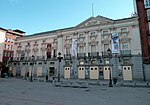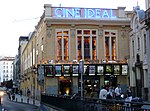St Sebastian's Church, Madrid

The Saint Sebastian Church or Iglesia de San Sebastián is a 16th-century church in central Madrid, Spain. It is located on Atocha street, #39. The name arises from a devotional chapel (ermita) which was found along the route to the Basilica of Nuestra Señora de Atocha, founded in 1541. The first architect around 1550 was Antonio Sillero, who also finished the Chapel of the Sagrado Corazón. This church like that of San Luis conserved for years the rights of asylum for those escaping official persecution. More chapels and enlargements were added by Antonio de la Tijera, Juan de Bulga Valdelastras, and Juan de Obregón between 1595 and 1598. The tower was built in 1612 by Lucas Hernández. During the Spanish Civil War, the church was sacked by Republican forces, before it ended up being almost destroyed during a bombing raid by the Nationalists around November 20, 1936. This caused many of the works to be transferred to other sites. For example, the icon of San Blas was moved to the convent of San Jerónimo el Real). The church was rebuilt in a different orientation by Francisco Íñiguez Almech between 1943 and 1959. In 1969, it was declared a "Bien de Interés Cultural" in the category of monument.
Excerpt from the Wikipedia article St Sebastian's Church, Madrid (License: CC BY-SA 3.0, Authors, Images).St Sebastian's Church, Madrid
Calle de Atocha, Madrid
Geographical coordinates (GPS) Address Phone number Nearby Places Show on map
Geographical coordinates (GPS)
| Latitude | Longitude |
|---|---|
| N 40.413583 ° | E -3.701556 ° |
Address
Parroquia de San Sebastián
Calle de Atocha 39
28012 Madrid (Centro)
Community of Madrid, Spain
Open on Google Maps










